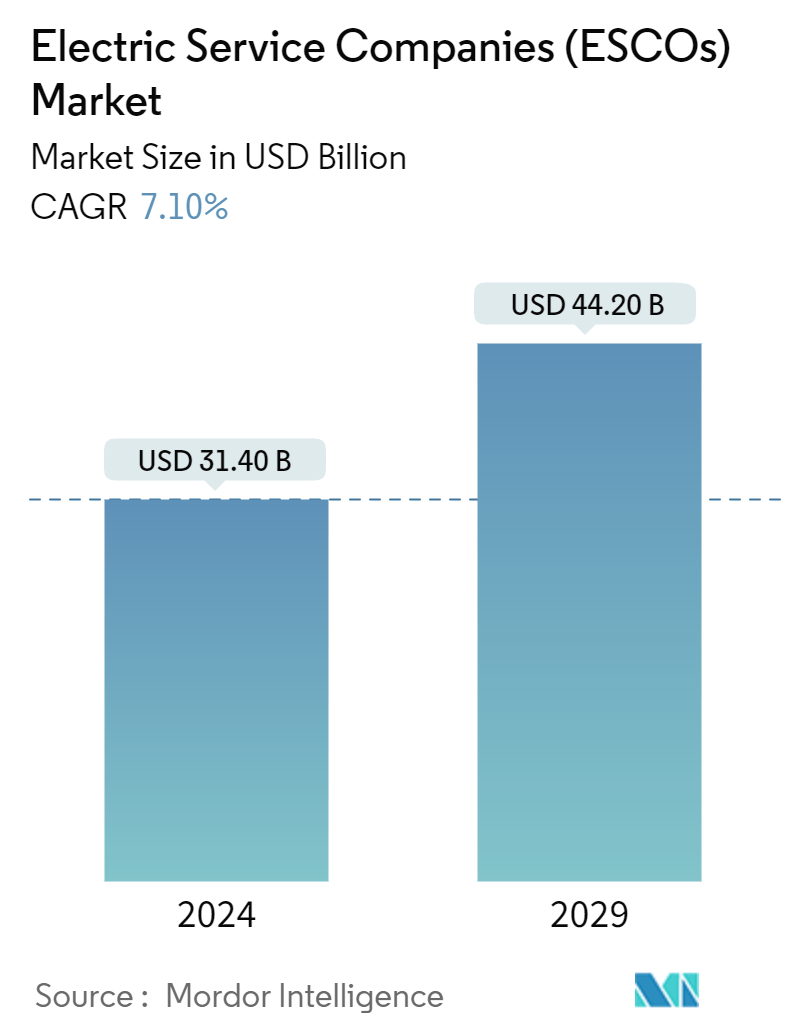Market Size of Electric Service Companies (ESCOs) Industry

| Study Period | 2019 - 2029 |
| Market Size (2024) | USD 31.40 Billion |
| Market Size (2029) | USD 44.20 Billion |
| CAGR (2024 - 2029) | 7.10 % |
| Fastest Growing Market | Asia Pacific |
| Largest Market | North America |
| Market Concentration | Low |
Major Players
*Disclaimer: Major Players sorted in no particular order |
Electric Service Companies (ESCOs) Market Analysis
The Electric Service Companies Market size is estimated at USD 31.40 billion in 2024, and is expected to reach USD 44.20 billion by 2029, growing at a CAGR of 7.10% during the forecast period (2024-2029).
- Electric Service Companies (ECSOs) specialize in delivering crucial operational, maintenance, and delivery services within the energy sector. ESCOs prioritize energy conservation by fine-tuning energy usage to align with an organization's consumption patterns. They can be set up to back a range of projects, from area revitalization and large residential complexes to commercial ventures such as offices, manufacturing facilities, hospitals, and multi-unit complexes featuring both offices and retail stores.
- One of the primary advantages of electric service companies is their ability to provide a consistent and reliable supply of electricity. This reliability is essential for both residential and commercial customers, ensuring that appliances, machinery, and critical systems operate without interruption. Electric service companies invest heavily in infrastructure, like transmission lines, power plants, and distribution networks, to maintain a steady flow of electricity, even during peak demand times or adverse weather conditions.
- Electric service companies are pivotal in weaving renewable energy into the grid as the world pivots towards sustainability. They seamlessly connect solar panels and wind turbines to the current infrastructure, optimizing the use of these green energy sources. Many of these companies are also channeling investments into research and development, particularly in energy storage technologies. Such advancements are crucial for harmonizing supply and demand in a grid increasingly dependent on intermittent renewable sources.
- The increasing demand for electricity is anticipated to offer lucrative opportunities for the growth of the market studied. According to Exxon Mobil, worldwide electricity demand amounted to over 22 petawatt hours in 2017. By 2040, electricity demand is expected to reach approximately 35.3 petawatt hours globally. Moreover, according to EIA, electricity generated worldwide is projected to rise by 70% in the coming three decades and reach 42 thousand terawatt-hours by 2050. That year, renewables are anticipated to be the significant source of global electricity, accounting for some 56% of the electric power produced.
- The renewable energy sector is experiencing growth and expansion globally. This growth is driven by various factors, including the need to strengthen energy security, combat climate change issues, reduce reliance on fossil fuels, and create economic opportunities.
- With the increasing energy demand and ageing electricity infrastructure, governments worldwide have increasingly moved toward modernizing energy grids by adopting smart grid solutions. Such moves have aligned with the growing propensity toward energy efficiency and renewable energy adoption, which will drive the market studied. For instance, according to the IEA (International Energy Agency), the world electricity demand is anticipated to increase by nearly 80% between 2012 and 2040.
- However, the growth of ESCOs in the decentralized energy market faces constraints due to substantial upfront costs, hindering their widespread adoption. Further, the increased inflation and interest rates reduced consumer spending, hampered the semiconductor, electronics, and robotics demand, and led to slow growth in the market studied. Furthermore, the United States and China trade war disturbed the global semiconductor supply chain. Additionally, owing to strict export and import controls on China by the United States for semiconductor manufacturing equipment, the production of the electronics sector is compromised, thereby affecting the industrial, commercial, and residential sectors.
- Moreover, the Russia-Ukraine war has negatively impacted the supply of specific raw materials used in semiconductor manufacturing, such as neon and palladium. These materials are critical inputs for certain stages of the manufacturing process, thereby challenging the growth of the market studied.

